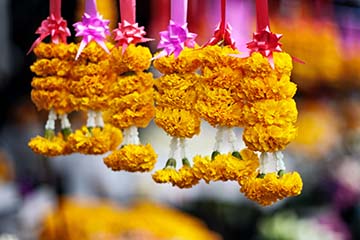Colour Code: Yellow
August 05, 2023

The colour
A warm-toned hue, yellow is super popular as a pick-me-up and as a neutral colour. In India, yellow has long been the choice for ethnic wear, especially during the festive and wedding seasons, as it is considered extremely auspicious. During the Indian pre-wedding custom of Haldi, it has almost become a norm for people to dress in this bright colour for the celebration. A dream colour, so to say! At Sodhani Biotech, we are constantly evolving and doing our best to develop and bring to you your favourite colours but without their toxic traits. Our dyes are both, planet-friendly and people-friendly.
Sources of yellow
All our natural dyes, at Sodhani Biotech, are derived from plant-based sources, mostly plant waste. For yellow, we use the extract of the marigold flower and the Himalayan rhubarb to obtain a gorgeous, warm hue we call Sun Yellow. Marigold is the colour of choice for religious and decorative purposes, across India. Unfortunately, a massive amount of these flowers go to waste, every single day, especially around religious sites and during wedding and other festivities. At Sodhani, we use extracts from unsold and wasted flowers to produce a powder-based dye that gives various shades of yellow, across the spectrum. Some of the popular shades obtained from this marigold extract are Sunny Yellow, Mustard Yellow, and Golden Yellow.
The Sun Yellow dye is suited for all textile dyeing (cotton, wool, silk, polyester, nylon, leather and even knitted or woven materials), paper dyeing, printing, tanning, and even for use in the food industry. It can be also dyed in cold water and is well fitted for both the Batch Process (Exhaust) and the Continuous Process dyeing methods. Continuous dyeing process is most popular for woven fabrics, whereas batch or exhaust dyeing is commonly employed in commercial fabric dyeing.
Why natural yellow?
The evidence of the antimicrobial and hypoallergenic properties of natural dyes has long been there. But did you know, plant-dyed textiles are suitable for even the most sensitive skin, such as that of babies. Besides being 100% biodegradable, our Sun Yellow dye has been associated with various medicinal uses, such as in the treatment of rheumatism, asthma, cough and bronchitis. Textiles dyed with our natural yellow have been found to display various natural antiseptic and anti-inflammatory properties, helping to manage eye infections and protecting our skin from oxidative damage, from environmental factors, including the UV rays from the sun. With the rarest of rare possibilities of triggering amild reaction, to those involved in its preparations. our Sun Yellow dye extract is an excellent choice for everyone!
DIY
Our dyes are extremely easy to work with. Start by wetting the fabric with a wetting agent/ soapnut (Reetha) or normal wash with water at 50 degrees for 20 min. You can pre-treat the material with alum, using a quantity that is 12% of the fabric weight, at 85°C for 60 minutes. Thereafter, add the required amount of dye to the dye bath and maintain the pH at 7. If the pH is higher than 7, add some vinegar to bring it down; if it’s below 7, use lime or soda ash to increase alkalinity. Stir well to dissolve the dye. Finally, add fabric to the dye bath and maintain at 95°C for 60 to 80 minutes. We check all our natural dyes at 5% of fabric weight, but you can amend the quantity as per your shade requirement—less for a lighter hue and more for a darker one. Post treatment, soap the dyed material with a non-ionic detergent (0.5gpl)—any detergent suited for delicate clothes or woollens will do—leaving it at 50°C for 35 minutes. Then cold wash at 50°C for 20 minutes or longer, if required.
Go mellow with our yellow
Be up in the latest news and hot offers by subscribing